A lot of the criticism I got for this post on Disney dimorphism was about how good animation inevitably exaggerates sex differences. (There are a lot of these comments on the Sociological Images version of the post and on the Slate re-write.) Here’s one example:
Cartoons aren’t meant to accurately portray people, EVER. They are meant to exaggerate features, so that they are more prominent and eye catching. So feminine features are made more feminine, and masculine features are made more masculine. … The less realistic the proportions, the more endearing and charming we find the character. The closer to realistic they are, the creepier/blander they can become.
Flipping through IMDB’s list of the top 500 animated movies reveals that Disney is certainly not alone in emphasizing the larger size of males. But there are a few successful counterexamples as well.
Here are some good ones where the male and female characters are similarly proportioned. Note these are not just random male and female characters but couples (more or less).
From Kiki’s Delivery Service by Hayao Miyazaki:
From Dreams of Jinsha:
Even some old Disney movies have romantic moments between physically-similar males and females. The original Snow White (from the 1937 movie) was paired with a Prince Charming whose wrists were barely bigger than hers (plus, look at her giant/normal waist!):
Disney non-human animal pairs were sometimes quite physically matched. Consider Bambi and Faline (Bambi, 1942):
Or Dutchess and O’Malley from Aristocats (1970) in which their exaggerated femininity and masculinity are not conveyed through extreme body-size difference:
In other realms of animation, Marge and Homer Simpson, the most durable couple in animation history, have very similar features: heads, eyes, noses, ears. His arms are fatter and neither of them really have wrists, but I’d put this in the category of normal sex difference:
Of course, Lucy and Charlie Brown were virtually identical if you think about it:
I’m open to other suggestions.
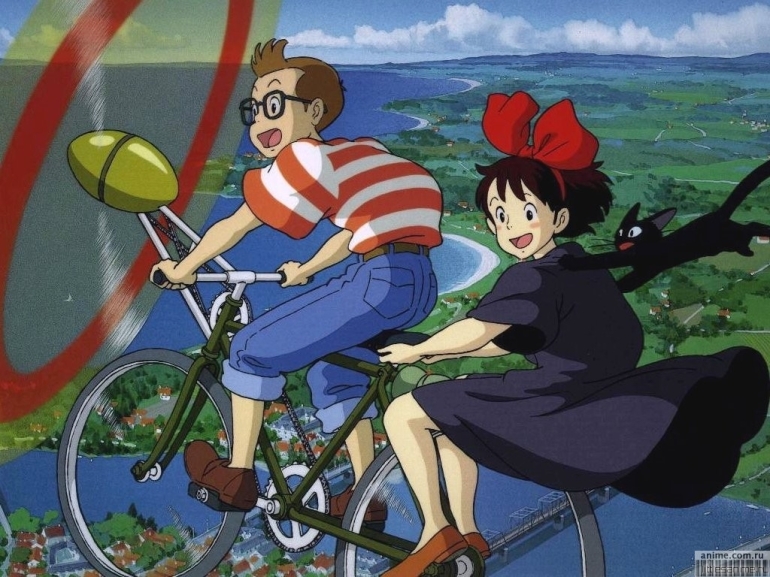


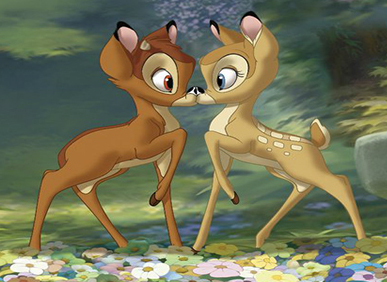
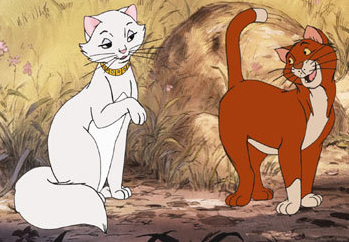
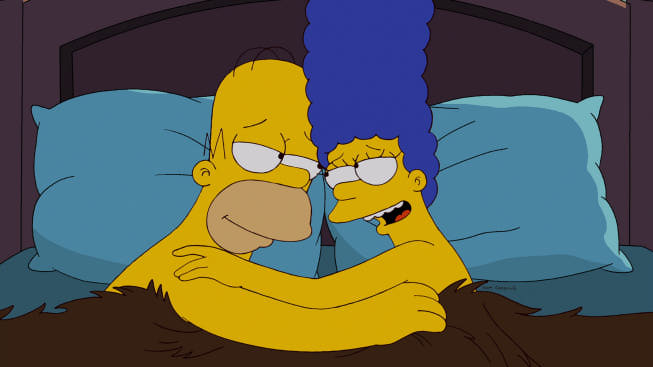
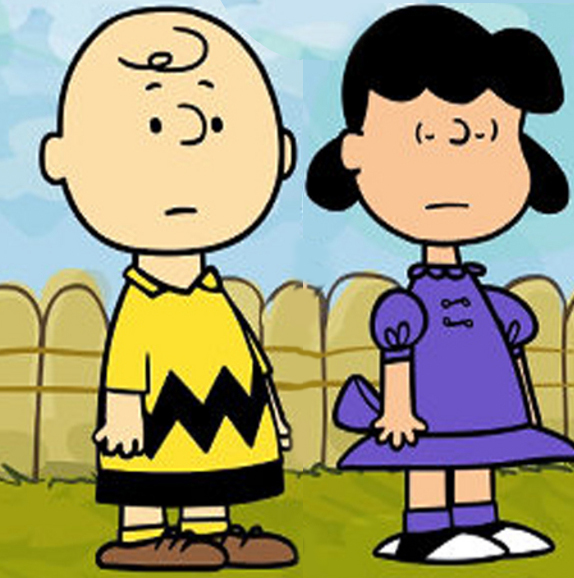

Here are some good ones where the male and female characters are similarly proportioned. Note these are not just random male and female characters but couples (more or less).
Two of your examples are via Japan. (I am not claiming any particular authority here, but I spend a fair amount of time in Asia, and am in Tokyo as I type this.) To my eye, there is less dimorphism in Asia than in Europe and Europe-descended societies. Japanese and Chinese men have far less facial hair, and are shorter on average then Caucasians. Also, to my eye, facial structure is less distinct, and hair/eye color is nearly uniform. To the extent I am correct, that means there is less difference to start with.
With regard to Bambi, perhaps you should also provide an image of the The Great Prince and compare it to Faline.
The most problematic element of your point of view is that Disney has some obligation to produce entertainment that you find visually and thematically correct. It doesn’t. It’s goal is to put butts in the seats; if more naturally proportioned characters, or more correct stories, reached that goal, then Disney would do it. Of course, there is the possibility that girls are so malleable that Disney’s movies are positively pernicious. In that case, then there should be a code that imposes correctness upon Disney’s works.
Alternatively, girls aren’t as helpless as all that, and Disney’s artistic choices are nothing over which to lie awake nights.
LikeLike
Jeff, you seem to have missed the point Philip was arguing. Philip quoted someone defending the huge male/tiny female thing claiming that good animation can’t “EVER” include realistic proportions. Studio Ghibli’s work (as well as Philip’s other examples), which any professional animator could tell you is among the very best produced in the world, shows that isn’t true – great animation doesn’t have to include ridiculously exaggerated sex differences in body types.
That’s not to say that a great animated piece can’t exaggerate body size differences between sexes. But it doesn’t have to.
I agree that Disney has no obligation to produce entertainment according to Philip’s specs; but this is a strawman argument on your part, since Philip never said it did. Just as Disney is free to produce the movies it wants, Philip is free to critique the sexism in Disney movies.
It’s not realistic to think that because Disney doesn’t do something, therefore it must not be possible to do that thing and have a box-office success. Before “Aladdin” Disney hadn’t done a feature-length animated movie with a non-white protagonist, and someone could have argued “if non-white protagonists would put butts in the seats, then Disney would do it.” But of course Aladdin made a lot of money for Disney, and so did some later Disneys with POC protagonists. Because something hasn’t been done before (or lately) isn’t evidence that it can’t be done successfully.
Besides, movies like “Snow White” and “Kiki’s Delivery Service” (in its English version as well as its Japanese version) have been very successful. So it’s nonsensical to imply that Disney can’t make a movie like that because it would automatically flop,
LikeLiked by 2 people
Miyazaki’s art style (both manga and anime) tends toward female and male characters who are similar in size regardless of age or the setting of the film, since many of the films take place in Europe or Europe-inspired fantasy settings. I think Kurenai no Buta/ Porco Rosso is the only one of his I can really think of where the men (mainly the comic-relief pirates) are much bigger than the female characters.
I don’t think it’s unhelpful to compare characters from Japanese media, especially when it’s from another large, well-known studio with a lot of cultural clout like Ghilbi. There’s a huge range of art styles, from Sailor Moon‘s 90s shojo elongated figures and tall men (I say that with great love for Sailor Moon) to something like Attack on Titan, in which the human characters have unisex uniforms and a more similar body-shape distribution, with 3 male characters (from the left: #3, #4, #6) falling toward the short end.
LikeLike
Didn’t finish that first thought! *And since many of the settings are European/inspired, the argument about Asian vs European body sizes doesn’t follow.
LikeLike
I have a few issues with the couples used. First of all, three of them are children who naturally have little dimorphism to begin with. If we’re going to study sexual dimorphism in cartoons, we need to start with, bare minimum, puberty when the most pronounced differences start to occur. Two of them are animals and out of those two animals, two are fawns. Cats, assuming they’re already in the same size category, don’t differentiate much sexually. Baby animals… really?
LikeLike
I’m pretty positive that the characters in both Kiki’s Delivery Service and Dreams of Jinsha have reached puberty; Kiki, for instance, is old enough to be living on her own, getting a job, and finding a boyfriend. (I think she’s supposed to be 13 years old; not full grown by any means, but already in puberty.)
LikeLike
Regarding Ghibli’s relative lack of dimorphism: Mononoke-hime’s Ashitaka and San are both about 17 and are very similar in build; although he is taller than her, it’s a slight difference. Moreover, the Tatara women are similar in height to him, and Lady Eboshi and Gonza are both taller than he is. There’s believable variation in adult build. (Also, Eboshi must have impressive upper-body strength to be able to handle one of the standard pre-Edo guns. I’ve seen them in real life, and they are huge and very heavy.)
LikeLike
Perhaps, it wouldn’t be the first time, and this could be the nth time.
I followed the first link in Dr. Cohen’s post, to a previous post here, the first line of which is I can’t offer much in the crowded field of Disney gender criticism.
I agree, good animation doesn’t have to grossly exaggerate dimorphism. For example, IMHO, Wallace and Gromit is an outstanding example of animation, the characters of which exhibit completely natural dimorphism.
However, SFAICT, Dr. Cohen’s reason for writing on this subject is that by exaggerating dimorphism, Disney is actively seeking to perpetuate culturally imposed gender stereotypes.
Hence my response. In part, Dr. Cohen cherry picked. One of the characters in Bambi, chosen as an examplar, exhibits all the anthropomorphized dimorphism that one could possibly hope for (or dread).
Yet that still leaves Disney open to exploiting, and perpetuating, existing gender stereotypes.
Which suggests that looking to animation that doesn’t exaggerate dimorphism also doesn’t exploit and perpetuate stereotypes.
Yet Wallace & Gromit does just that. Well, to be more clear, W & G, even though it doesn’t exploit dimorphism, leaves stereotypes wholly untouched.
LikeLike
something you seem to be missing as well that i think is relevant (this is to those disagreeing with the problems in animation)
maybe animation wants to exaggerate feminine and masculine features, but consider eyes. women and men have relatively similar sized eyes, yet women are always portrayed as having hugely disproportionate eyes. This is not based on anything in reality, but is done to make women appear more innocent (like baby eyes). There is a problem in wanting women to be innocent (i.e. pure, virginal), as we take them less seriously and as less of a threat, and make them seem younger, lesser, and sillier than men.
Also, no matter the intent or the reason behind the exaggeration of features, there are very real and negative consequences to this. Making a heroines waist and arms and legs tiny, and her breasts and eyes huge, holds up an ideal of women being outlandishly disproportionate in an inhuman sense. This leads to eating disorders, objectification, and feeling inadequate in many girls and women.
Thanks for the article
LikeLike
There’s a reason why we want a non-threating female.
Say I want to get a girlfriend. There are two girls. One have big eyes, and look very innocent, and non-friendly. The other one have intense sharp eyes (a psycho killer), and look like she would kill me in my sleep. Of course I would choose the girl with the big eyes. Has nothing to do with society. Has everything to do with not wanting her to kill me in my sleep. Maybe you should think about that.
LikeLike
Well, the fact of the matter is cartoons are inherently, and generally understood to be, abstract. Thus you will have cartoons that display varying forms of realism. I find the animation of Frozen, Brave, and Hercules, to name a few, to be quite visually appealing, which is ultimately the effect we’re going for.
They’re stylized, but I don’t think sexism inherently follows from that, at least on it’s own. The characters look fine, and Disney has even gotten quite a bit better at having strong female characters in recent years. I don’t think sexual dimorphism is the problem.
Now, it would be nice to perhaps see some different body types portrayed as attractive alongside the thin, athletic builds of most Disney characters, but that is again an issue with story and not with animation, which is ultimately pretty trivial when examining a work’s social impact. I’ve seen articles about Frozen where it is ridiculed because the eyes of the characters are larger than their wrists, but this is equally ridiculous as pointing out all the ways Spongebob is out of proportion when compared to a real sponge. For that matter, all of the less dimorphous characters are stylized too, both the young deer you hold up as examples have eyes bigger than their hooves
If the issue is unrealistic body expectations then that is perhaps a valid point, but referring back to the analogy I just used, these characters are stylized pretty obviously and obviously do not represent reality. It’s not like Barbie dolls which seem to claim to be realistic. Even young children understand that Elsa and Anna are cartoons.
I don’t think dimorphism in appearance is inherently bad. Equality will come about not just when girls are allowed to be masculine, but when so-called feminine characteristics are not seen by Anti-feminists and feminists alike as somehow demonstrating weakness. Maybe it’s a stretch to say that an obviously feminine character with a pink frilly dress and tiny wrists but who is nevertheless a strong character embodying of feminist ideals and who doesn’t tolerate inequality is a progressive idea, but maybe it isn’t. It’s certainly a refreshing change from the archetype of the tomboy at odds with her femininity, as if someone can’t enjoy both traditionally masculine and traditionally feminine things.
Feminism is principally about equality, and equality is not about eliminating femininity from society, it’s about demonstrating that femininity is NOT synonymous with weakness.
Of course, tangentially, I do not want to perpetuate an idea that men and women should fill different, unequal roles, and I think masculinity and femininity are pretty arbitrary concepts. There is nothing inherently feminine about a pink frilly dress, it’s just a collection of cloth, just as there was never anything masculine about pants. Feminism has made a lot of progress in that traditionally masculine things are now, in many cases, totally permissible for girls (although paradoxically, it is common to find in feminist circles that traditionally feminine things are not). But yet for the most part traditionally feminine characteristics are strongly frowned upon in males. since they are still seen as weaknesses.
Most of the people I hang around are female, and we all identify as feminists, and we’re all completely different people. I know some who would hate the prospect of wearing a dress or playing with dolls or wearing makeup. They enjoy things that are traditionally “masculine”, and I’m thankful to see that this is becoming pretty socially acceptable.
One of my closest friends prefers skirts over pants, and likes to wear eyeliner but not foundation. She is not, thankfully, driven by societal expectations but rather just by what she likes. She is not weak or passive, she insists on paying whenever we go places, and her dream is to become a teacher. Once while we were at a store she stopped to look at jewelry but quickly moved on, apologizing for being overtly “girly” as if there was something wrong with that (there isn’t). I think part of the backlash to the feminist movement is this idea that feminism is diametrically opposed to all things traditionally feminine, though of course it isn’t.
Another person I know was on the royalty court for our small, conservative county, and drives a car with pink decals, but is also a state qualifying wrestler. She does not struggle between being athletic and competent, and being girly, they are not issues that conflict. Yet another person I encountered claimed to oppose feminism, because she thought that getting being a domestic and raising children was perfectly fine for her, and felt that feminists would oppose such a life. I told her that feminism isn’t about turning every woman into an aromantic career woman, feminism is just about making sure that society’s ideas of what a woman should do are not forced upon women, or for that matter, men. If you want to be a domestic fine, if you want to wear dresses and makeup fine, but those are choices that each woman must make, they shouldn’t be forced by societal expectation. Feminists had alienated her because it just so happened she wanted to be more traditionally feminine, and they implied that doing so was akin to surrendering to oppression.
Returning to the original point. Avatar the Last Airbender and it’s sequel is one of the best examples of gender-equal programming. The characters were not stock characters of their gender, nor did they treat gender as something to be ignored. The characters were stylized and dimorphous, and had independent struggles. Their gender was part of their identity but didn’t define them. Sexism and gender equality were also directly explored as themes, often juxtaposed with strong female characters that demonstrated how ridiculous gender inequality really is. It would be pretty difficult to argue that this show is sexist, and yet the characters are somewhat dimorphous and drawn out of proportion (though it should be noted that couples of varying relative size and age are portrayed). Meanwhile, a show might be drawn realistically, with characters of perfect proportion and be completely sexist.
Nitpicking the proportions of obviously stylized characters isn’t helping the cause of equality.
LikeLike